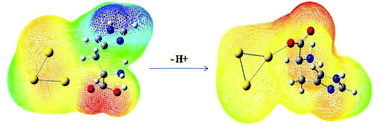Interactions of coinage metal clusters with histidine and their effects on histidine acidity; theoretical investigation†
Abstract
Understanding the nature of interaction between metal

* Corresponding authors
a
Department of Chemistry, Sharif University of Technology, P.O. Box: 11365-9516, Tehran, Iran
E-mail:
fattahi@sharif.edu
Tel: +98-21-66165342
b
Chemistry and Chemical Engineering Research Center of Iran, P.O. Box: 14335-186, Tehran, Iran
E-mail:
jamshidi@ccerci.ac.ir
Tel: +98-21-44580720
Understanding the nature of interaction between metal

 Please wait while we load your content...
Something went wrong. Try again?
Please wait while we load your content...
Something went wrong. Try again?
M. J. Javan, Z. Jamshidi, Z. A. Tehrani and A. Fattahi, Org. Biomol. Chem., 2012, 10, 9373 DOI: 10.1039/C2OB25711D
To request permission to reproduce material from this article, please go to the Copyright Clearance Center request page.
If you are an author contributing to an RSC publication, you do not need to request permission provided correct acknowledgement is given.
If you are the author of this article, you do not need to request permission to reproduce figures and diagrams provided correct acknowledgement is given. If you want to reproduce the whole article in a third-party publication (excluding your thesis/dissertation for which permission is not required) please go to the Copyright Clearance Center request page.
Read more about how to correctly acknowledge RSC content.
 Fetching data from CrossRef.
Fetching data from CrossRef.
This may take some time to load.
Loading related content
